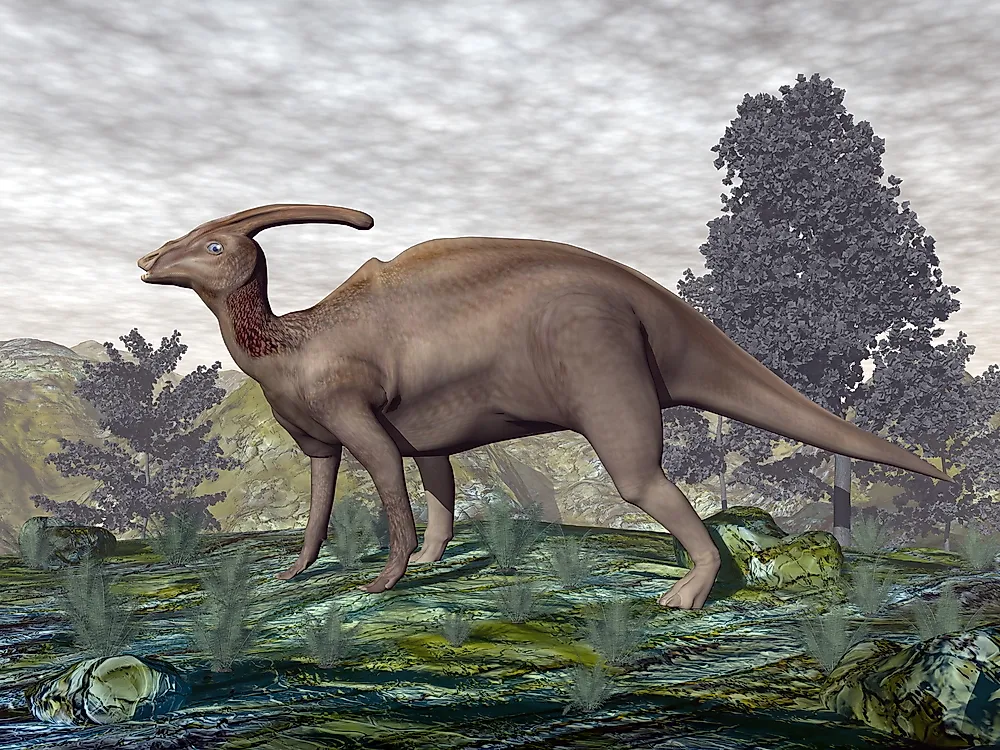Parasaurolophus Facts: Extinct Animals of the World

The Parasaurolophus was a dinosaur that lived between 76-73 million years ago in the late Cretaceous period. Also called duck-billed dinosaurs, they exist in three universally recognized species. These species are Parasaurolophus walkeri, Parasaurolophus tubicen, and Parasaurolophus cyrtocristatus. The Parasaurolophus is famous for its bizarre head adornments which are inclusive of the large cranial crest it possesses. It was both bipedal and quadrupedal. However, in order to travel long distances, it could not use the two hind legs alone, it had to use all four legs. The Parasaurolophus lived in present day North America. Dr. William Parks discovered its first remains in Alberta, Canada in 1922. They were made up of a partial skeleton and a skull. Other remains have been found in Utah (US) and in Heilongjiang (China). The name “parasaurolophus” was derived from a Greek word “near crested lizard.”
Physical Description
The Parasaurolophus was a hadrosaurid. It was estimated to have been 4 meters tall and 10 meters in height with a weight of 3-5 tons. The crest on its head made it stand out among the rest of the dinosaurs. The function of the crest was unknown to most paleontologists. However, they suggested that it could have been used for thermoregulation, acoustic resonance, and/or visual recognition. The crest was made of nasal bones and premaxilla. It was hollow and had distinct tubes running through it to each nostril, then the end of the crest and back to the skull. Some species of Parasaurolophus had long crests while others had short ones. The Parasaurolophus had an average intelligence. Parasaurolophus walkeri is said to have had invariant tubercle-like scales on its skin.
Diet and Feeding
The Parasaurolophus were herbivorous dinosaurs who fed on vegetation. It could feed from the ground and on higher vegetation up to 4 meters high. Some of the food it ate were ginkos, leaves, and pine needles. It had a beak which was used to crop plants. The beak was held onto the jaws by an organ resembling a cheek. Furthermore, the Parasaurolophus’ jaw had hundreds of teeth packed in batteries. The teeth were continually replaced during their lifetime. The skull of the Parasaurolophus could permit it to chew and grind food while feeding. The dinosaur would use its two hind legs to run at a speed of 25 miles per hour in order to escape from its predators.
The Crest’s Use for Communication
Most recently, scientists have proven that besides the other probable functions of the crest, it was also a communication tool. It was used to identify the young, adult, male or female Parasaurolophus. The female and young Parasaurolophus had shorter crests compared to the adult and male Parasaurolophus. The crests enabled them to emit beautiful sounds as a way of communicating with each other. The males are believed to have had deeper voices than the females.
Filming of the Parasaurolophus
The Parasaurolophus has made appearances on several films such as Disney’s Dinosaur, Jurassic Park, and Turok. In all these films, the dinosaur has played different roles. In the Disney’s Dinosaur and Jurassic Park, it is a herd member whereas in the Turok as a docile plant eater.











